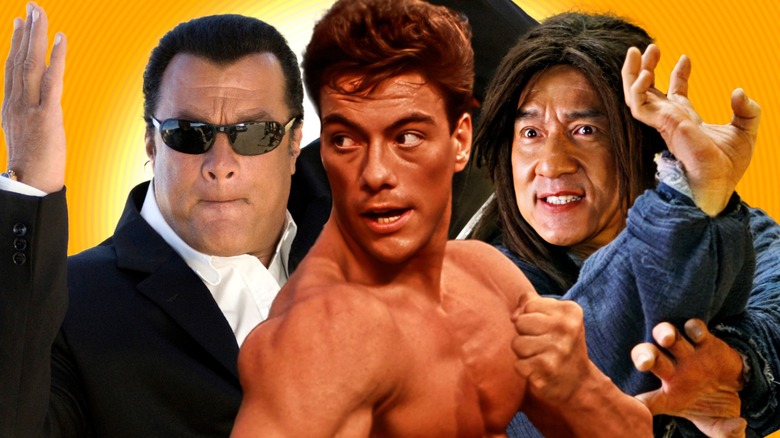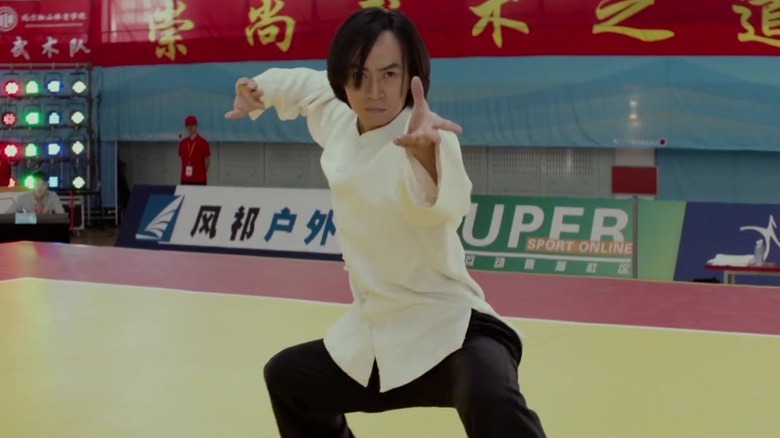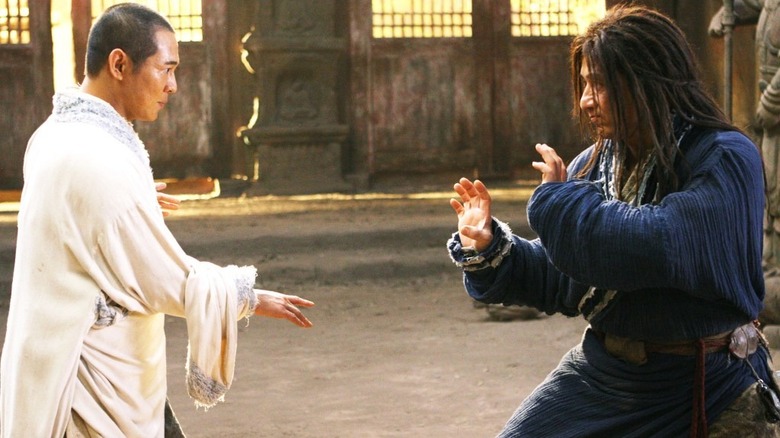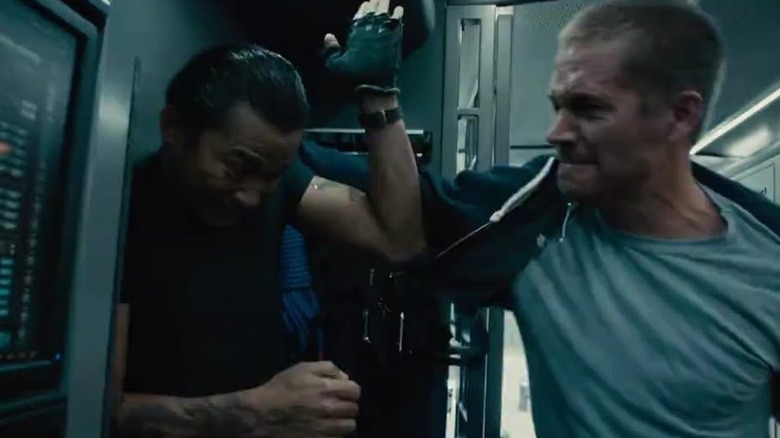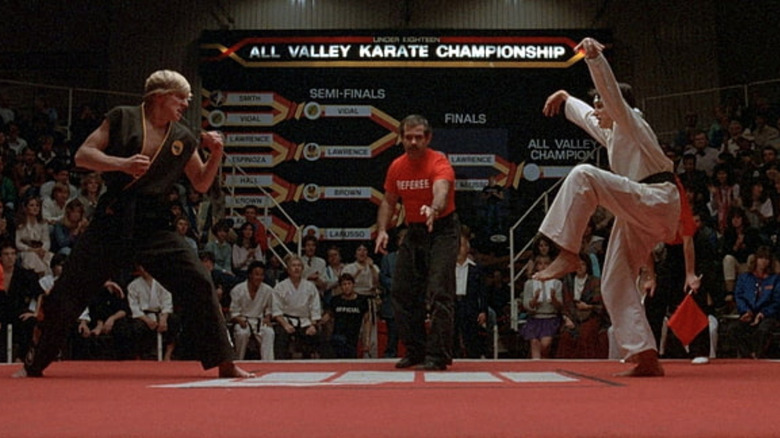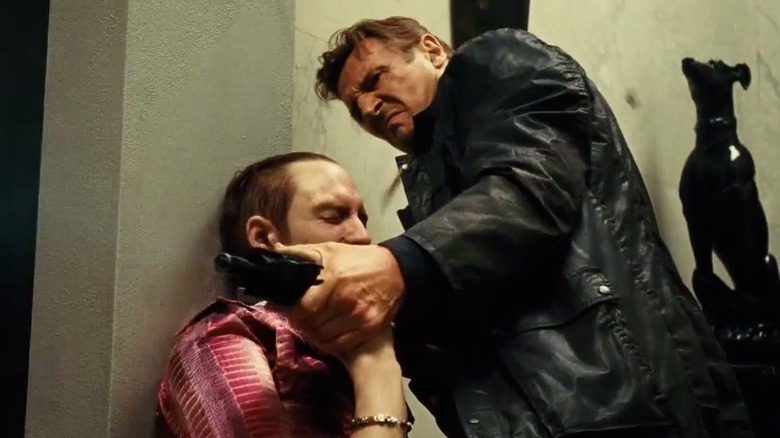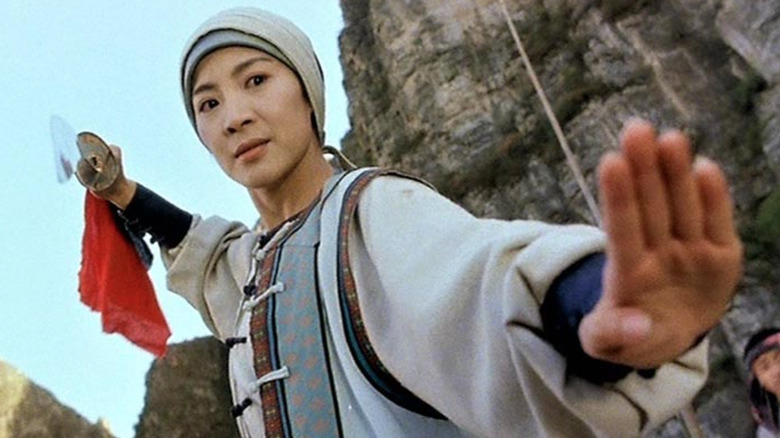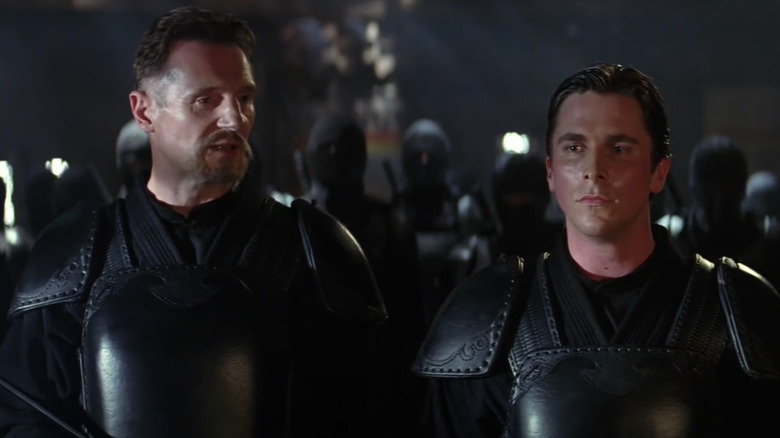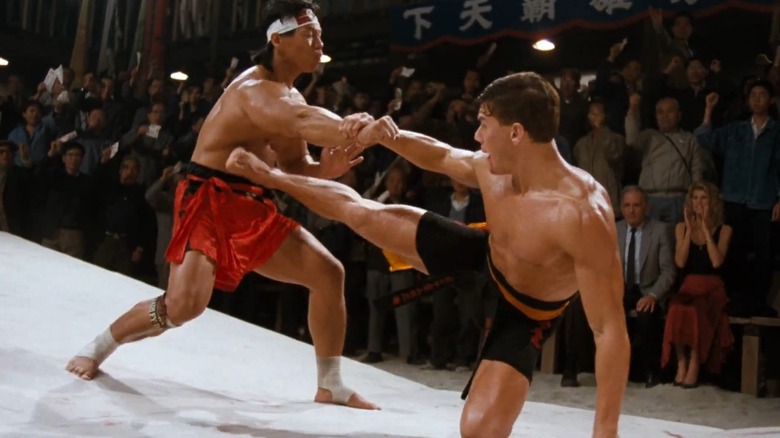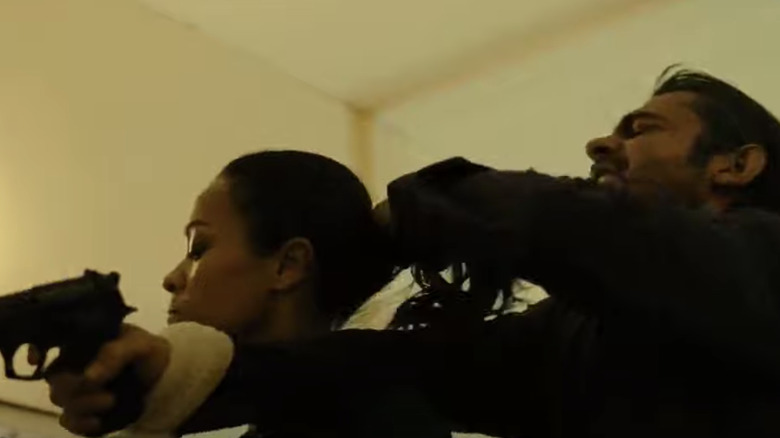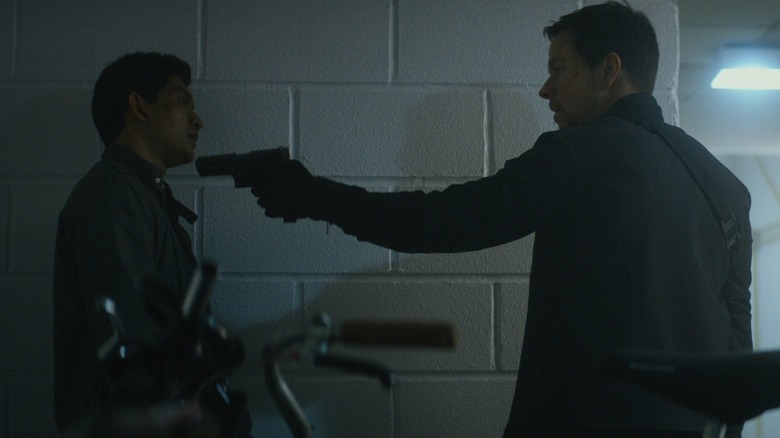Movies That Totally Botched Martial Arts Fighting Styles
From boxing to judo and from jiu-jitsu to eskrima, there are nearly 200 different fighting styles that originated in various countries all around the world. Many of these martial arts styles have been brought to the big screen in action movies over the years, but they aren't always translated into cinema faithfully.
To one degree or another, there is always some realism lost when a martial arts style is depicted on camera. Beyond all of the trickery needed to keep action scenes safe for the actors and stunt performers involved, movie fight choreography rarely ever sticks to a single real-world fighting style on a one-to-one basis. Movements often need to be exaggerated in order to sell on camera, some real fight tactics simply aren't exciting on screen, and some moves that are exciting on screen would be useless in a real fight and have no basis in reality.
100% authenticity in a movie fight scene sounds like something worth striving for at face value, but it would be easy for the end result to wind up being dull and unimpressive. The best action movies strike the perfect balance between realism and exaggeration, while other movies throw realism out the window and botch the fighting styles they claim to depict. Here are 11 martial arts movies that got their fighting styles completely wrong.
Man of Tai Chi - Tai Chi
From the kung fu of "The Matrix" to the judo of "John Wick," Keanu Reeves has consistently proven himself to be one of the most physically committed Hollywood stars. In 2013, Reeves's passion for martial arts extended behind the camera with his directing debut: "Man of Tai Chi." Reeves plays the film's villain opposite martial artist Tiger Chen, whom Reeves met while working on "The Matrix" trilogy as a stunt man. Reeves also met the legendary fight director Yuen Woo-Ping on "The Matrix" and enlisted him to work on the action scenes for "Man of Tai Chi."
Despite being a total financial bomb, Reeves delivered a remarkably authentic kung fu flick. However, there was a notable lack of authenticity when it came to the titular martial arts style. Despite it being in the title, there is hardly any legitimate tai chi used in the film. In reality, tai chi is not an offensive fighting style and instead finds far more use as a light exercise suitable for the elderly. In the film, the so-called "Man of Tai Chi" is constantly on the aggressive and tears his opponents apart. This is one instance of a movie getting the martial arts style completely wrong but winding up with better action because of it. The fights in "Man of Tai Chi" are fun and exhilarating, whereas if they stuck to actual tai chi, they would be slow, dull, and the protagonist would certainly lose every fight.
Forbidden Kingdom – Drunken Boxing
1978's "Drunken Master" was a pivotal film in the early career of the legendary Jackie Chan. Many years later, he returned with "The Legend of the Drunken Master" in 1994. Both movies feature Chan using the unique drunken boxing martial arts style. As the name implies, this fighting style is based around the notion of the fighter acting like someone who is extremely drunk with fluid, unpredictable, and seemingly uncoordinated movements that can trick their opponent and catch them off guard. As bizarre as it seems, drunken boxing is a real martial arts style that dates back many centuries and has been incorporated into combat sports at the professional level.
After perfecting the cinematic portrayal of drunken boxing in these two earlier films, Chan utilized the fighting style once more in the 2008 movie "The Forbidden Kingdom." Rather than being a welcome return to the iconic fighting style for Chan, drunken boxing was badly botched on this third outing. While the two "Drunken Master" movies are classics of the Hong Kong film industry, "Forbidden Kingdom" was written and directed by two Americans and starred a teenager as the protagonist, leaving the actual martial arts masters Jackie Chan and Jet Li playing second fiddle. The anglicized production carries through into the presentation of the martial arts and destroys any sense of authenticity. The film also injects a thin veneer of a mishandled Wuxia with floaty physics and copious wire work, which clashes with the unorthodox yet grounded drunken boxing style.
Furious 7 - Muay Thai
Tony Jaa is a world-famous martial artist from Thailand who fights using the country's trademark Muay Thai style. Jaa's first English-language blockbuster was "Furious 7," in which he played the supporting villain role of Kiet. There was clearly an attempt to bring Jaa's signature Muay Thai fighting style into the long-running "Fast & Furious" franchise, but it was unsuccessful for a couple of key reasons.
The first pitfall was the setting. The Thai films "Ong-Bak" and "The Protector" show Jaa in top form with acrobatic maneuvers, spins, flips, and flying knee and elbow strikes, but his big fight in "Furious 7" takes place in the cramped confines of the back of a tech bus where he has no room to do the flashy moves he is known for. Alongside the hampered choreography, the fight is also mangled in the editing room. The scene cuts to new angles every few frames and is chock full of continuity errors with both fighters constantly jumping positions between cuts.
Something that was a boon to Jaa's early martial arts films was that stuntmen in the Thai film industry were frequently on board to take full-contact hits from Jaa. This led to plenty of behind-the-scenes injuries but made the fight scenes that much more spectacular to witness. Of course, in a Hollywood film like "Furious 7," safety is a much higher priority, and full-contact fight scenes don't fly.
The Karate Kid (1984) - Karate
The original "The Karate Kid" is easily one of the most famous martial-arts-focused movies to come out of the west. The film led to sequels, a remake, video games, and the eventual "Cobra Kai" spin-off series. However, all that success doesn't mean the film was an accurate portrayal of karate.
Some of the karate showcased in the film was partially based on reality. Other parts were completely fabricated, including Daniel LaRusso's (Ralph Macchio) signature move: the crane kick. The actual kick itself resembles a real karate kick, but the silly pose with Daniel holding his hands up in the air above his head has no basis in reality. Using this iconic film move in real life would accomplish nothing other than looking ridiculous while leaving your guard wide open. The film also gets the history of Karate wrong. Mr. Miyagi (Pat Morita) explicitly states that the style did not originate in Buddhist temples in China before making its way to Japan as other movies incorrectly suggested. In reality, the movies Mr. Miyagi is deriding are correct, and "The Karate Kid" is wrong.
Mr. Miyagi's iconic catch-a-fly-with-chopsticks training does not stem from karate either. There is an unverified rumor that Bruce Lee once caught a fly with chopsticks, which is likely what the film based this element of Daniel's training on. If the rumor is true, it would just be another of the many impressive physical feats Lee pulled off that has nothing to do with martial arts, like playing ping pong with nunchucks. Lee was not a karate fighter in the first place and instead fought using jeet kune do, his own style that blended multiple martial arts forms, none of which were karate.
Taken 3 - Nagasu Do
In the "Taken" series, Bryan Mills (Liam Neeson) uses the same fighting style throughout all three movies. The style is known as Nagasu Do and is actually a combination of three other martial arts styles: Jiu Jitsu, Judo, and Aikido. Nagasu Do is one of the more recent martial arts styles out there and was created by Mick Gould, who has been working as a Hollywood trainer and technical advisor on action movies since the mid '90s, including working directly with Liam Neeson and the filmmaking team on the first "Taken" movie. The martial arts style also finds a lot of real-world use and is one of the official fighting style that British SAS Officers are trained in.
Nagasu Do is implemented well in the original "Taken" movie, but the style's depiction grew significantly worse and worse in the two sequels as the directorial duties exchanged hands from Pierre Morel to Olivier Megaton, who, frankly, seems clueless when it comes to shooting and editing action. The action scenes in the first movie were far from being perfectly clear, but the sequels pushed the shaky camerawork and hyper-active editing to new extremes. "Taken 2" was a huge step in the wrong direction, and by the time "Taken 3" rolled around, the action was essentially unwatchable. This third outing is hilariously badly edited and infamously used 14 different camera angles in the space of about five seconds to show the simple feat of Neeson climbing over a fence.
Wing Chun - Wing Chun
Wing Chun is a classic Chinese martial arts style with a storied history that stretches back centuries. These days, the style is most closely associated with Donnie Yen and the "Ip Man" franchise. More than a decade earlier, he previously co-starred in "Wing Chun" in 1994 alongside Michelle Yeoh, who plays a character named Wing Chun and is the inventor of the titular fighting style.
For a movie called "Wing Chun" with a plot all about the martial arts style that bears its name, it probably comes as a shock that the vast majority of the fighting in the movie does not utilize the Wing Chun style at all. In the Hong Kong action movie industry, martial arts styles are typically presented with far more authenticity than their western counterparts, which makes the failure to present the titular fighting style all the more disappointing. Beyond disappointing audiences, Yen himself can even be heard lamenting the lack of Wing Chun fighting in the film's DVD bonus features.
When it came time for Yen to star in "Ip Man," his experiences working on "Wing Chun" were essentially worthless as he needed to learn the Wing Chun martial arts style from scratch and trained under the real Ip Man's son to pick up the basics. Luckily, watching Yeoh and Yen throw down is still entertaining regardless of their fighting styles.
The Dark Knight Trilogy - Ninjitsu
A significant portion of "Batman Begins" is devoted to showcasing the caped crusader's training in the ninjitsu martial arts style with the League of Shadows under Ducard aka Ra's al Ghul (Liam Neeson). The training he undergoes certainly plays a factor in Batman's stealth tactics, but his actual fighting style is not ninjitsu at all despite claims to the contrary.
Throughout Christopher Nolan's "Dark Knight" trilogy, Batman fights using Keysi, which is also known as the Keysi fighting method rather than being labeled as a traditional martial arts style. "Batman Begins" is actually credited as being the first film to bring Keysi to the big screen. In the years since James Bond can be seen using the Keysi style in the Daniel Craig era, and Tom Cruise became a proponent of the style and utilized it in both the "Mission: Impossible" series and the "Jack Reacher" series.
Batman's training under Ra's al Ghul was a unique addition made for "Batman Begins" and is not a part of the character's backstory in his long comic-book history. In the comics, Batman is a master of numerous fighting styles, but Keysi is not one of them. In fact, the Keysi fighting method wasn't established until 1980, long after the Batman character came into existence.
Bloodsport - Dux Ryu Ninjitsu
In 1988's "Bloodsport," the muscles from Brussels Jean-Claude Van Damme stars as Frank Dux, an American secret agent (though he makes no attempt to hide his Belgian accent) who Infiltrates a deadly martial arts tournament known as the Kumite. Frank Dux is a real person, and the story along with Van Damme's character was based on his life. The only problem was that Dux turned out to be a complete fraud. Despite the poster, trailer, and credits all proclaiming that the film is telling a true story, it is all 100% fake. The cast and crew of the film likely had no idea they were telling a fictional story since Dux had pretty much the entire world fooled at one point.
Alongside false claims of winning the deadly underground fighting tournament and being given the Medal of Honor, Dux also claimed to have developed his own martial arts style that he named Dux Ryu Ninjitsu. Dux served as the fight coordinator of "Bloodsport" and use his Dux Ryu Ninjitsu style for the film's choreography. This is a unique case of a movie not necessarily botching a fighting style but rather the fighting style itself being botched. As the name implies, Dux Ryu Ninjitsu used traditional ninjitsu as its basis. Dux claimed that his style was a drastic improvement on the foundation of the actual martial arts style when it was really just a botched version of ninjitsu.
Colombiana - Krav Maga
"Colombiana" is a 2010 action movie about an assassin (Zoe Saldana) hunting down the man who murdered her parents. The film was written by Luc Besson and Robert Mark Kamen, the same team behind "Taken," and directed by Olivier Megaton, who directed both "Taken" sequels. Taking this into account, it should come as no surprise that the action sequences in "Colombiana" are practically incomprehensible.
Judging by the infinitely clearer behind-the-scenes footage, it is apparent that Saldana really put in the work and trained hard to become skilled in Krav Maga and with firearms and other weapons. However, by simply watching the movie, you probably wouldn't get that impression. The blame lies entirely on Megaton and editor Camille Delamarre, who also served as Megaton's editor on the "Taken" and "Transporter" sequels. The choreography and physical performances happening on set would likely be impressive to watch in real life, but the fight scenes are mangled beyond all recognition in the editing room.
It becomes downright laughable how many different camera angles are used to cover a single fight. The hyperactive editing rarely lets shots last for more than a couple of frames before jumping to the next shot. To make the fights even more of a jumbled mess, many of the shots are confusing close-up inserts and frequently break the 180-degree line, which makes screen direction impossible to follow. "Colombiana" is a strong contender for the title of 'worst edited action movie of all time' alongside "Taken 3."
Mile 22 - Silat
Iko Uwais and Welsh director Gareth Evans had earlier worked together on the low-budget martial arts flick "Merantau," but it was their two "The Raid" movies that followed that rocketed them both to international acclaim. The director and star both went on to careers outside of Indonesia after the success of "The Raid 2," but Uwais's feature film starring roles abroad have been far less successful.
One of Uwais's biggest Hollywood roles was as the villain in "Mile 22" opposite Mark Wahlberg, which was set in Indonesia and smartly allowed Uwais to act partly in his native language. "Mile 22" was the fourth of the five feature-film collaborations between Wahlberg and director Peter Berg so far. The thin plot and shallow characters are just an excuse to deliver numerous action sequences, which would be totally fine if the action wasn't extremely difficult to follow with all of the shaky camerawork and choppy editing that obfuscates it. What was clearly intended to make the action feel more gritty and intense instead makes it harder to parse what is happening and obscures whatever impressive martial arts moves Uwais was performing on set.
Uwais was involved behind the scenes and helped choreograph his own action sequences. It's a safe bet that he did a good implementing his trademark Silat aka Pencak Silat fighting style into the fight choreography, but it is nearly impossible to appreciate his work given how Berg presents the action sequences visually.
Every Steve Seagal movie made in the last 20 years - Aikido
Aikido is a Japanese martial arts style that is largely defensive in nature. Aikido is focused on disarming assailants and avoiding getting hurt rather than dishing out damage yourself. One of the core tenants of the style is seeking to end a violent conflict without either party getting hurt. The non-violent nature of this particular martial art makes it an odd choice to feature in action movies. Nonetheless, aikido is the primary fighting style of Steven Seagal, who is the world's most famous practitioner of the form.
Seagal made Aikido seem far more aggressive and violent than it is in reality but presented many of the form's moves accurately in his first couple of movies. Pretty soon, however, his career fizzled out. He began starring exclusively in direct-to-video action movies where he seems to put in as little effort as possible. Regardless of how good Seagal was in his prime, he has considerably slowed down and gotten out of shape as his career has gone on. He no longer seems physically capable of pulling off the fight scenes in his movies, or maybe he just doesn't care enough to try. His 2017 movie "China Salesman" is a good indicator of his modern output and displays his penchant for moving as little as possible in fight scenes while relying heavily on obvious body doubles and stunt doubles to do most of the work.
